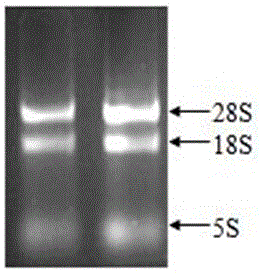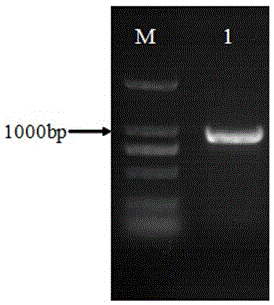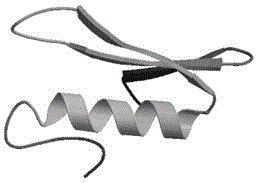Application of panax japonicus transcription factor gene PjERF1
A technology of transcription factors and ginseng, which is applied in the fields of molecular biology and genetic engineering, can solve the problems of resource depletion and habitat destruction of ginseng, and achieve the effect of increasing gene expression and increasing yield
- Summary
- Abstract
- Description
- Claims
- Application Information
AI Technical Summary
Problems solved by technology
Method used
Image
Examples
Embodiment 1
[0021] Example 1: PjERF1 Gene cloning and bioinformatics analysis
[0022] Because Ginseng contains more secondary metabolites, a two-step method is required for the extraction of total RNA. First, the improved guanidine isothiocyanate method was used for crude extraction, followed by digestion with DNase and extraction with chloroform to obtain relatively pure total RNA of Ginseng ginseng ( figure 1 ). Use reverse transcriptase M-MLV (promega) to synthesize the first strand of cDNA using the total RNA of Ginseng ginseng as a template. The reaction system and operation process are as follows: Take 5 μg Total RNA, add 50 ngoligo (dT) in sequence 15 , 2μL dNTP (2.5mMeach), DEPC water to a reaction volume of 13.5μL; after mixing, heating and denaturing at 70°C for 5min, then rapidly cooling on ice for 5min, then adding 4μL 5×First-standbuffer, 0.5μL RNasin (200U), 1μL M- MLV (200U), mix well and centrifuge briefly, incubate at 42°C for 1.5h, take it out and heat at 70°C for 1...
Embodiment 2
[0025] Embodiment 2: plant expression vector construction
[0026] Use the SanPrep column type plasmid DNA mini-extraction kit (Shanghai Sangong) to extract the insert PjERF1 coli plasmid pGEM-T- PjERF1 As well as the plasmid of the plant expression vector pCAMBIA2300S, 1 μL was used for agarose gel electrophoresis to detect the integrity and concentration of the extracted plasmid. use Xba I(TaKaRa) and Sma I(TaKaRa) for plasmid pGEM-T- PjERF1 Carry out double digestion with pCAMBIA2300S (100μL system), the reaction system and operation process are as follows: take 20μL pGEM-T- PjERF1 or pCAMBIA2300S plasmid, add 10 μL 10×Tbuffer, 10 μL BSA, 5 μL Xba I, 5μL Sma I, 50 μL ddH 2 O, after mixing, centrifuge for a short time, and place at 37°C for overnight reaction. Spot all digested products on agarose gel for electrophoresis, and then PjERF1 The fragment and the pCAMBIA2300S large fragment were gel-recovered separately, and the SanPrep column DNA gel-recovery kit (S...
Embodiment 3
[0029] Embodiment 3: Agrobacterium-mediated genetic transformation of Ginseng
[0030] Take out the stored pCAMBIA2300S containing pCAMBIA2300S from the -80℃ refrigerator -PjERF1 The Agrobacterium EHA105 strain of the plasmid was inoculated in 5 mL of LB liquid medium containing 50 mg / L Km and 25 mg / L rifampicin, and cultured at 28°C until cloudy. Pipette 1mL of turbid bacterial solution onto LB solid medium containing 50mg / LKm, and incubate at 28°C for 48h. Scrape off an appropriate amount of Agrobacterium on LB solid medium and inoculate it in MGL liquid medium, add 40 mg / L acetosyringone, and shake at 28°C until OD 600 When it is 0.6, stop shaking the bacteria, and the obtained bacterial solution is used for infection.
[0031] The callus of Panax ginseng in good growth state was transferred to MS pre-medium (containing 35 mg / L acetosyringone) and pre-cultured for 3 days. After the pre-cultivation is completed, the callus is completely immersed in the above-mentioned Ag...
PUM
 Login to View More
Login to View More Abstract
Description
Claims
Application Information
 Login to View More
Login to View More - R&D
- Intellectual Property
- Life Sciences
- Materials
- Tech Scout
- Unparalleled Data Quality
- Higher Quality Content
- 60% Fewer Hallucinations
Browse by: Latest US Patents, China's latest patents, Technical Efficacy Thesaurus, Application Domain, Technology Topic, Popular Technical Reports.
© 2025 PatSnap. All rights reserved.Legal|Privacy policy|Modern Slavery Act Transparency Statement|Sitemap|About US| Contact US: help@patsnap.com



